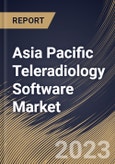Cloud-based teleradiology software is gaining traction due to its flexibility and scalability. It allows healthcare providers to securely store, access, and share medical images while minimizing infrastructure costs. With the increasing complexity of medical imaging, there is a growing emphasis on subspecialty reporting. Teleradiology software is evolving to support the reporting of specialized cases, ensuring patients receive the most accurate diagnoses. Mobile applications and platforms are becoming increasingly important in teleradiology. Radiologists can now access and interpret images on smartphones and tablets, offering flexibility and mobility in their work.
AI-powered decision support systems assist radioalogists by offering insights and recommendations during image interpretation. These systems can help in the early detection of diseases, reducing false positives and false negatives. Blockchain technology is being explored to enhance data security and integrity. Teleradiology software can offer additional security against unauthorized access and data breaches by generating a tamper-proof, decentralized ledger of patient records and image data. Automation is becoming a staple in teleradiology software, with reporting tools automatically generating structured and standardized reports. This not only saves time but also ensures consistency in reporting. Teleradiology software is expanding to support teleultrasound and telemammography, enabling remote interpretation of ultrasound and mammography images. This is particularly significant in women's health and prenatal care.
Teleradiology has significantly improved access to radiology services in India, especially in underserved and remote areas. Many teleradiology providers offer 24/7 services, ensuring that healthcare facilities in India can access radiological expertise anytime. Teleradiology networks connect Indian healthcare providers with specialized radiologists from across the globe. Teleradiology software in India is increasingly incorporating AI for image analysis. AI algorithms can assist radiologists in detecting abnormalities, speeding up the diagnostic process.
The United Nations predicts that by 2045, nearly 450 million Chinese citizens will be 60 or older. The aging population in China has created a sustained demand for teleradiology services and software essential for enhancing the quality of care for elderly patients. Teleradiology not only enhances access to diagnos tic imaging but also plays a crucial role in diagnosing, treating, and managing age-related health conditions, ultimately improving healthcare outcomes for this demographic. All these factors will uplift the regional market expansion in coming years.
The China market dominated the Asia Pacific Teleradiology Software Market, by Country in 2022, and would continue to be a dominant market till 2030; thereby, achieving a market value of $262.5 Million by 2030. The Japan market is registering a CAGR of 10.2% during (2023 - 2030). Additionally, The India market would showcase a CAGR of 11.7% during (2023 - 2030).
Based on Deployment, the market is segmented into Web-based, Cloud-based, and On-premise. Based on Type, the market is segmented into Picture Archive and Communication System (PACs), Radiology Information System (RIS), and Vendor Neutral Archive (VNA). Based on countries, the market is segmented into China, Japan, India, South Korea, Singapore, Malaysia, and Rest of Asia Pacific.
The market research report covers the analysis of key stake holders of the market. Key companies profiled in the report include Carestream Health, Inc. (Onex Corporation), Teleradiology Solutions, Inc., Comarch SA, RamSoft, Inc., Koninklijke Philips N.V., Morton and Partners Radiologists, Everrtech Software Private Limited, Pediatrix Medical Group, Inc., Siemens AG, and Radical Imaging LLC.
Scope of the Study
Market Segments Covered in the Report:
By Deployment- Web-based
- Cloud-based
- On-premise
- Picture Archive and Communication System (PACs)
- Radiology Information System (RIS)
- Vendor Neutral Archive (VNA)
- China
- Japan
- India
- South Korea
- Singapore
- Malaysia
- Rest of Asia Pacific
Key Market Players
List of Companies Profiled in the Report:
- Carestream Health, Inc. (Onex Corporation)
- Teleradiology Solutions, Inc.
- Comarch SA
- RamSoft, Inc.
- Koninklijke Philips N.V.
- Morton and Partners Radiologists
- Everrtech Software Private Limited
- Pediatrix Medical Group, Inc.
- Siemens AG
- Radical Imaging LLC.
Unique Offerings
- Exhaustive coverage
- The highest number of Market tables and figures
- Subscription-based model available
- Guaranteed best price
- Assured post sales research support with 10% customization free
Table of Contents
Companies Mentioned
- Carestream Health, Inc. (Onex Corporation)
- Teleradiology Solutions, Inc.
- Comarch SA
- RamSoft, Inc.
- Koninklijke Philips N.V.
- Morton and Partners Radiologists
- Everrtech Software Private Limited
- Pediatrix Medical Group, Inc.
- Siemens AG
- Radical Imaging LLC.








